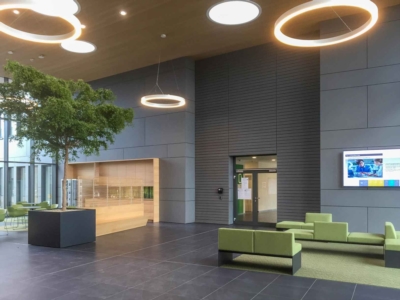




"For every project, we use technology," points out Patrick Meyer. Working in BIM (Building Information Modeling) is therefore part of the daily work of the office, a working methodology that is a real plus for customers: "For our customers, it's much easier to read a 3D plan, so we're sure they understand exactly what we've done. By showing them something so concrete, they know what to expect and can tell us what's wrong with them. "
If proceeding in such a way requires more investment upstream, it is therefore all benefit for the owner, but also for the architects themselves. "Drawing in 3D allows us to minimize the risk of errors, and thus avoid unpleasant surprises on site".
Another positive point of this technology, it allows to keep a close eye on the cost of a building. A significant detail, especially since it is no secret: money is the nerve of war.
The question of the budget is also discussed with the client from the first meeting: "It is important to know the budget available, so as not to promise something that, in the end, is unachievable complement".
During the first meeting, the important thing is also to establish a relationship of trust, so as to target all of its needs: "To understand these, just like his everyday life, especially if the owner is the end user, we must slip into the shoes of a psychologist. Without dialogue, it is indeed impossible to dissect his wishes. This is important because we are not building for ourselves, but for someone who will occupy the same habitat for years. "
Depending on the client, the approach will vary, with the promoter having a different vision and reasoning from the private sector. To all, the same request is however formulated to them, as Patrick Meyer mentions it: "We invite them to show us pictures of buildings they like. Often, they are surprised by this request. But for us, it's a way to get to know them better, and therefore to be able to offer them something they like. The visual of a house, or even a building in New York can inspire us, even if it may seem completely out of context. I like to say that being an architect also means being a translator: what our clients formulate with words and images, we transpose it into constructions ".
To propose a building that evolves over time is one of the difficulties encountered by architectural professionals. For Patrick Meyer, it is essential to work around this problem.
"Take the case of a house. When designing the project, we will create '' 2 in 1 ''; one for the current situation, and one for the future. Because in 20 years, the family situation of the occupants will have changed, the children will have grown up and will wish more private space or, on the contrary, they will have left home. How to adapt the space? Our role is to bring an answer to this question, not by demolishing half of the housing, but by adapting it according to the new needs ".
"From this moment, the interior designer intervenes" adds Katrin Cartus, interior designer at Belvedere Architecture, before going on: "the well-being of the future occupants depends in particular on the work on lighting, acoustics, the integration of techniques, the planning of development work, the choice of furniture, but also the choice of materials, colors and surfaces ".
While making the daily lives of the end users is essential, the architectural gesture still has its place, "if the budget allows, and it brings a specific feature". "This is, for example, a detail in a room, in order to bring in the light. This being the case, continues Patrick Meyer, each building does not have the vocation to be the Eiffel Tower. What we have to propose is first of all something functional, not a work of art. "
Installed for a few months in Contern, the Belvedere Architecture premises are just like the projects led by his team: maximize, while reducing costs and environmental impacts. Thus, several structures, like the block in the entrance, were recovered from Howald, where the office was until last August.
For Patrick Meyer, it is important for his teams to feel good about their workplace. For example, in the open space, he had installed individual separation blades, so that each employee can stay focused behind his computer. On the other hand, at the slightest movement, and depending on the angle in which he is, everyone can see his colleagues. An original way to understand the space, and to (re) discover it under different facets.
"The salary and the car are no longer, today, the only elements that a worker takes into account. To this problem, we try to answer them in each of our projects of office building ". This is particularly the case for the Luxembourg Automative Campus, a building designed to accommodate 400 employees. "It was designed to promote communication between employees. In addition to meeting rooms, they will have the opportunity to meet in meeting points, as well as in semi-open communication modules scattered throughout the complex, and equipped with acoustic and visual protections ".
Another project is the development of an office space of 300m² in Belval. "This is a challenge since the amount of natural light is low. In order to solve this problem, the development of the plateau was done in open-space. It can quickly become noisy so, again, a solution was thought: individual boxes, protected by a wooden frame covered with a polycarbonate cladding that lets in light, and insulated acoustically. What to allow each employee to retire in a more confidential space when he needs more concentration ".
At the rate of every 3 weeks, Belvedere Architecture takes part in a working group composed of different trades involved in a construction project. The goal? Analyze a building composed of a glass roof, and see how it can work, despite the technical constraints that are grafted on. One way to see the limits, but also to solve them. What provide some lines of thought for the future.
In addition, the structure managed by Patrick Meyer is not only active in the architecture. Interior design is also at the center of the office's occupations, led by Karin Cartus. "The role of the interior designer is important, he must take part in a project from the beginning, just like an architect. If he intervenes only at the end of the chain, to choose the furniture or the color of the walls, his job is quite different, and then looks more like that of interior decorator ".
Among the other services provided, that of project management, coordinated and directed by Joachim Engstler. "Through this mission, our role is to advise the client, to accompany him. We must show him the feasibility of his project, expose him to the solutions available to him, while establishing a link between him and all the actors involved. He is, in a way, acting as a conductor ".
Note, to be complete, that Belvedere Architecture is also able to carry out urban planning projects. A panoply of skills gathered around a common goal: customer satisfaction.
Belvedere Architecture
7, rue des Chaux
L-5324 Contern
Phone : (+352) 26 34 06 10
Email: info@belvedere.lu
www.belvedere.lu